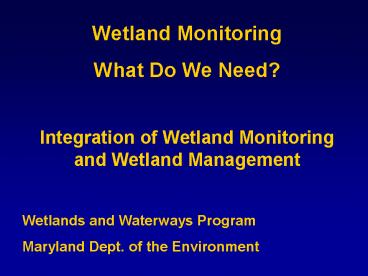Wetland Monitoring - PowerPoint PPT Presentation
1 / 10
Title:
Wetland Monitoring
Description:
Challenges to Compilation and Use of Monitoring Information in a Wetland Regulatory Program ... photos, design plans. Additional Resources Needed: Funding ... – PowerPoint PPT presentation
Number of Views:24
Avg rating:3.0/5.0
Title: Wetland Monitoring
1
Wetland Monitoring What Do We Need? Integration
of Wetland Monitoring and Wetland Management
Wetlands and Waterways Program Maryland Dept.
of the Environment
2
Maryland Departments of Environment, Natural
Resources, Agriculture, Transportation involved
in various wetland management activities Dept.
of Environment Regulatory programs in tidal
and nontidal wetlands Agriculture and
Forestry Mitigation Restoration Planning and
technical assistance Monitoring Water Quality
Standards
3
Wetland Monitoring and Assessment program,
methods, and tools should support other
management activities Maximize use of existing
or routinely collected information Minimize
uncoordinated or inconsistent approaches and use
of additional agency resources Consolidate
related information in data management system for
multiple activities
4
Wetland Monitoring and Regulatory Program
Implementation Focus on rapid assessment
(Level 2) supplemented by GIS (Level 1) and
intensive data sampling (Level 3) Consider
condition and function Variety of
reference sites Site specific data within
watershed
5
- Use information collected in regulatory permit
process - plant species, soils, hydrology, land use,
wildlife use, degradation, functions - ease of access
- Statewide coverage
- Supplement with other field inventories
- public lands
- GIS
- Other lands
6
- Other Existing Information
- water quality, biological, stream
stability, flood studies - Management Plans
- Functional assessments
- Local surveys
7
- Challenges to Compilation and Use of Monitoring
Information in a Wetland Regulatory Program - Lack of staff time
- Scattered information sources
- Various resource management goals
- Suggested solution.
8
- Develop integrated data management system
- Existing system
- proposed impacts
- authorized impacts
- wetlands, floodplains, sensitive
species, archeological/historical sites,
watershed - Proposed system adds
- wetland/water quality/biological assessment
results - reference sites, restoration sites,
preservation areas - management plan recommendations
- photos, design plans
9
- Additional Resources Needed
- Funding
- Programming expertise
- Data conversion and entry
- Field studies
10
- Regulatory and Non-regulatory Management Benefits
- Improves targeting of restoration and
protection areas - Improves information exchange between
programs - Improves consistency of management decisions
- Improves efficiency of permit process































